11 Mistakes You Might Be Making When Cooking Oysters
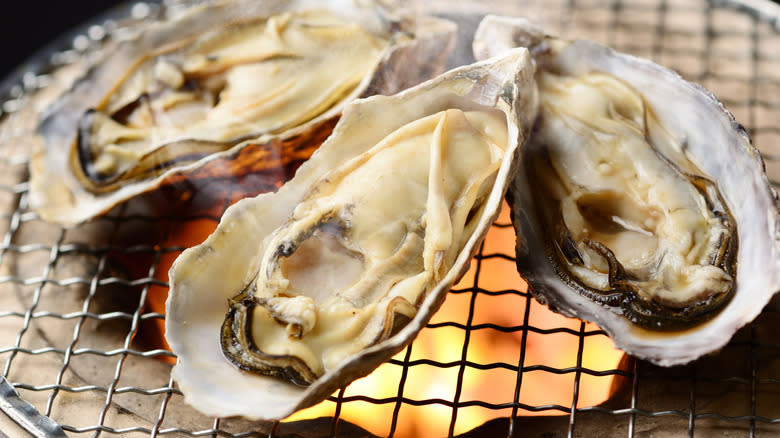
As with several other species of mollusk, oysters can be enjoyed both raw and cooked. The former course involves a few simple steps: clean, shuck, and enjoy. In contrast, cooking oysters can be a complex process involving breading and frying, delicate poaching techniques, or fire-side grilling. Unfortunately, any mistake made during these processes can transform the delicate, briny wonders into chewy, tasteless pellets. All of which begs the question, why bother?
Firstly, there is the matter of food safety. Oysters are known to harbor a bacteria called Vibrio vulnificus which can cause severe nausea and, in extreme cases, death. The U.S. Food and Drug Administration highlights that the best means of protecting yourself from Vibrio vulnificus is thoroughly cooking the oysters before consuming them as heat destroys the bacteria.
Secondly, cooking oysters allows chefs to achieve textures and flavors that are not associated with the bivalve when it is served raw. Fried oysters become crisp, glazed oysters taste spicy, and poached oysters develop a decadent plumpness. All these changes can add welcome variety to an oyster lover's repertoire while also providing novices with a less intimidating way of sampling the mollusk.
To ensure your oyster experience is a good one, we have highlighted 11 common mistakes made during the various cooking processes along with simple measures to avoid them. If followed, these tips will help transform even the biggest skeptic into a passionate ostreaphile.
Read more: 13 Tips To Make Your Shrimp Taste So Much Better
Assuming All Oysters Have Similar Uses
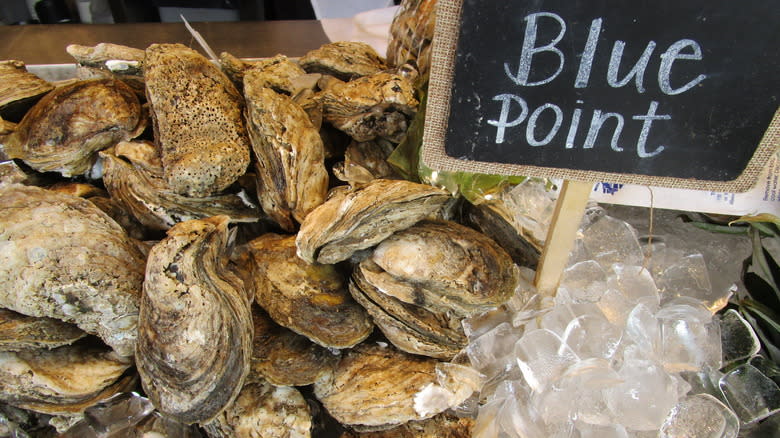
The first mistake many cooks make is assuming that all oysters can be used in the same way. This is not the case. There are five species of oyster harvested in the United States: Kumamoto, Pacific, Atlantic, Bélon, and Olympia. All of these species branch out further into a number of different oyster varieties. Each of these varieties has unique characteristics that make them suited to different cooking processes. For example, Blue Point oysters, a type of Atlantic oyster, are often deemed the best oyster for frying due to their meaty texture while delicate, sweet Kumamoto oysters are better suited to poaching.
It's not just species and varieties that dictates how an oyster should be used; size matters too. This was highlighted to HuffPost by oyster expert Lauren McCool who, when discussing Pacific oysters, said: "You can eat the small ones with a mignonette or fresh-shaved horseradish. For the bigger ones, you can go nuts with much more intense flavors without overpowering the flavor of the oyster." With that in mind, cooks who wish to create heavily flavored oyster dishes like Oysters Rockefeller should source large oysters that can stand up to the strong flavors of cheese and bacon.
Storing Them Incorrectly
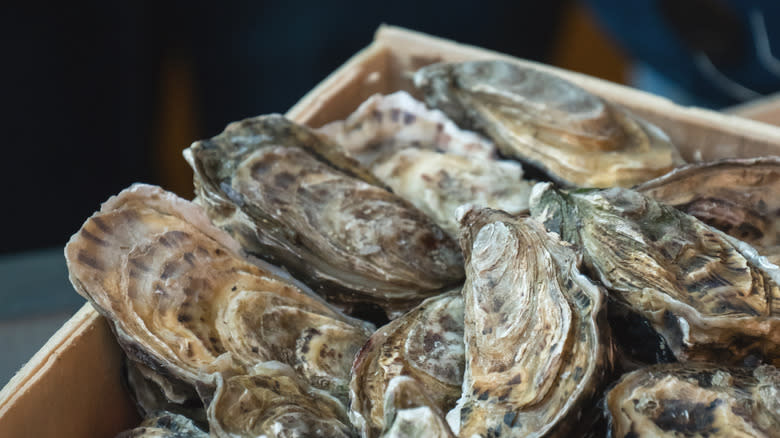
No matter which type of oyster you buy, storing them correctly is of immense importance. When purchased in their shells oysters are alive and every home cook's goal is to keep them that way until just before serving. Keeping the oyster alive not only maintains the oyster's fresh flavor but, as MasterClass highlights, also prevents the build-up of potentially dangerous bacteria. After all, a dead oyster is a decomposing oyster.
As marine animals, it is vital that live oysters are not stored in tap water; it will poison and kill them. Live oysters also need to breathe. As such, avoid placing them in airtight containers. Instead, they should be placed in the fridge and covered with a damp towel. It is advised to put them in a dish or on a rimmed baking sheet to reduce the risk of cross-contamination.
Shucked oysters are already dead. This means they can be stored in ways that live oysters cannot. For example, shucked oysters are perfectly fine in an airtight container or placed on ice. Just remember that cold temperatures are a must to inhibit the growth of bacteria. Around 34 to 35 F is deemed best.
Shucking The Oysters Too Early
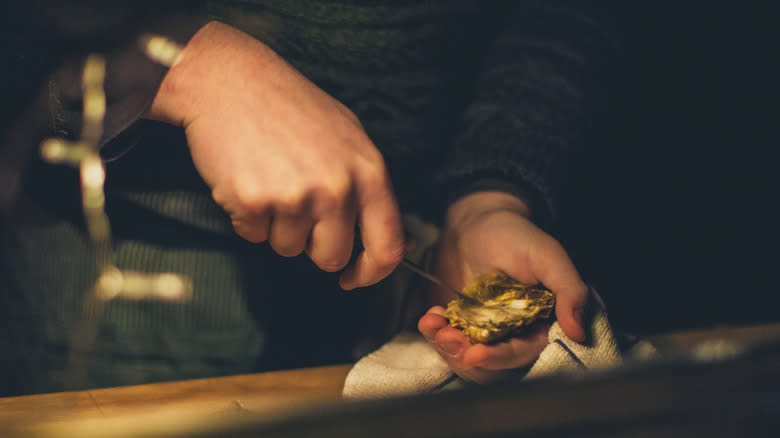
When entertaining, we all like to get ahead of the game. But while some prep lends itself to being done in advance, shucking oysters does not. This is because shucking oysters nearly always kills them. Even if stored properly afterward, shucking the oysters a day or two in advance can significantly blunt the bivalve's flavor. As such, it is advised that an oyster is shucked just prior to cooking and serving.
Of course, freshness is less of an issue if the oyster is merely a vehicle for other robust flavors. You may not be able to tell the difference between an oyster shucked yesterday and one shucked today when it sits under a pile of bacon and melted cheese. However, in more delicate dishes, including those calling for poached oysters, freshness is all important.
It's not just shucking that should occur as close to dining as possible but harvesting too. If you can source, prepare and eat them on the same day your guests -- and tastebuds -- will thank you.
Throwing Away The Oyster Liquor
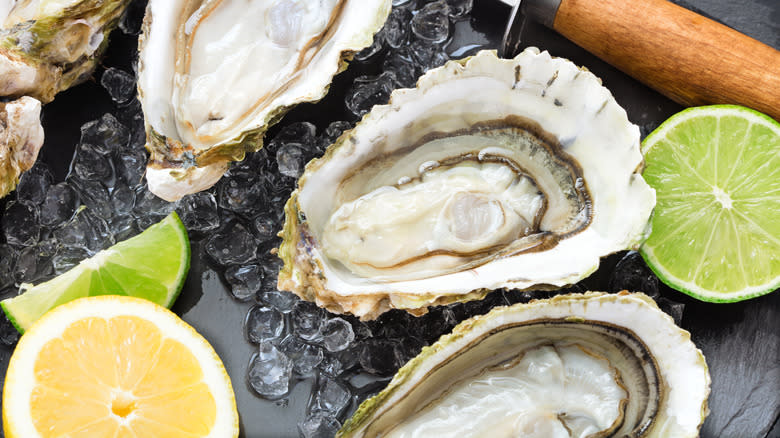
When in the shell, oysters are surrounded by a mixture of the bivalve's juices and seawater. This is known as oyster liquor. Drinking the liquor is a well-loved part of the raw oyster eating experience, but its applications in the kitchen are less celebrated. Cooks often discard the liquor without a second thought.
This is a shame as oyster liquor has a variety of culinary applications. It can be used as a rich stock to flavor dishes such as seafood risotto or added to sauces and dips to enhance flavor. Other applications include using the liquor to deglaze pans; an immensely flavorful pan sauce is the result.
As with other aspects of the bivalve, the liquor is influenced by the environment in which the oyster lives. In extreme cases, the prevalence of certain types of algae in the water can turn the liquor a variety of colors including red and gold. These visual changes are accompanied by new flavors. For example, Marenne oysters boast a green liquor which is known for tasting uniquely rich. Usage of the oyster's liquor should vary according to its flavor.
Overlooking The Impact Of Merroir

Merroir is a term that carries the same significance for oysters as terroir does for grapes. Both are used to describe how farming techniques, the surrounding environment, and climate affect the characteristics of the finished product. In oysters' case, the effect is especially pronounced; although there are only five different species of oyster harvested in the United States, merroir ensures that there are hundreds of oysters with their own distinct characteristics and flavors.
Savvy farmers manipulate merroir to develop marketable characteristics in their oysters. For example, the team at White Stone Oysters grow their oysters near the surface of Chesapeake Bay giving the oysters a cleaner flavor. What's more, due to the area's surf, the oysters develop plump meat and attractively polished shells, perfect for serving on the half shell.
While cooks don't possess the ability to manipulate merroir, they can make the most of it by matching certain oysters to different preparation methods. For example, mineral-heavy oysters -- that have been farmed close to the sea or riverbed -- should be cooked via a robust process like grilling. Sweeter, lighter-tasting oysters are better suited to subtle cooking methods like poaching. Oysters that have been farmed in a mixture of fresh and saltwater -- and thus have a well-rounded flavor -- are a great addition to gumbos, stews, and chowders where they perform a supporting role.
Not Breading Them Correctly
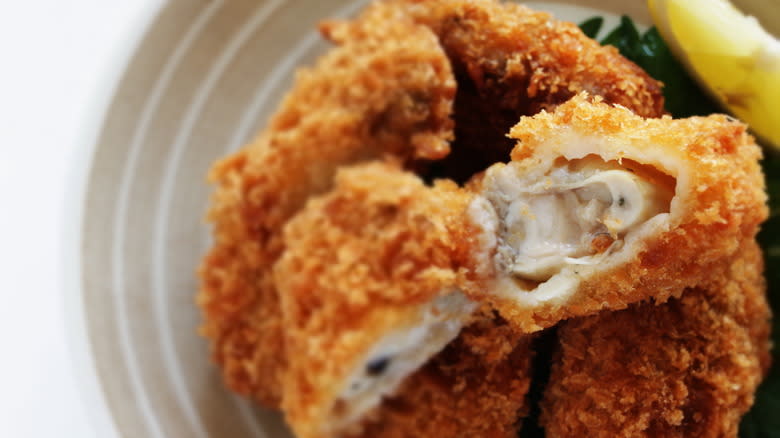
In the southern U.S., frying is the preferred method for cooking oysters. One of the key attractions to this style is the batter that evenly coats the mollusk which should be light, crisp, and flavorful. Anything less and you've doomed a perfectly good oyster to mediocrity.
The cause of many subpar fried oysters is poor breading. Often, cooks struggle as the breading refuses to stick to the oyster's surface. An excess of moisture is often to blame. To solve this issue, simply drain the oyster of its liquor by placing it in a colander. Those with less patience can pat the oyster dry with a paper towel, although this method means the liquor cannot be used for anything else.
Many cooks prefer to use a dry-wet-dry technique wherein oysters are doused in flour, dipped in a wet batter of eggs or buttermilk, before being dipped in breadcrumbs or flour once again. To ensure lightness, oysters should only be covered in a small amount at each step lest the meat-to-breading ratio become unappetizingly low. The use of light breadcrumbs, like Panko, also helps.
Finally, flavor is ensured by mixing some salt and spices into the flour mixture. Personal preference will dictate specific choices but common additions include paprika and garlic powder.
Believing Raw Or Fried Are Your Only Options
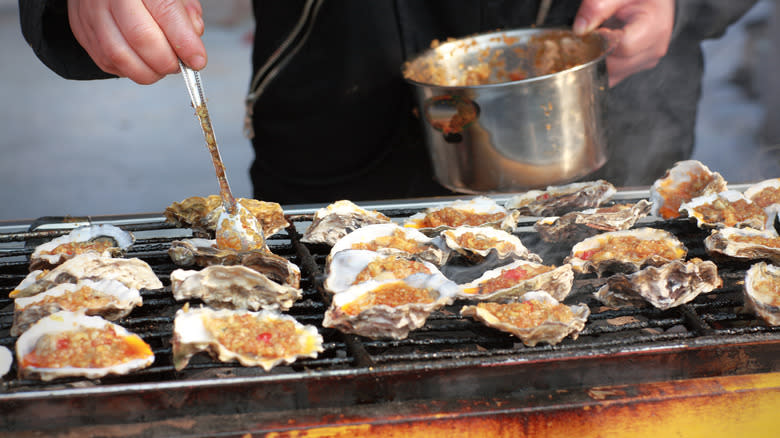
Raw and fried oysters are the types most commonly enjoyed in restaurants and homes across the United States. While these are two brilliant ways to prepare the mollusk, they unfortunately overshadow other cooking methods which are as good if not better.
One of these methods is grilling. Simply placing the closed, cleaned oysters on the grill imbues them with a slightly smoked flavor. What's more, it negates the need for forceful shucking as the oysters open naturally during cooking. If already on the half shell, a butter mixture can be added directly to the meat providing even more flavor. As with frying, this cooking method works best with meaty, flavorful oysters.
As previously mentioned, poaching is a great way to cook delicate-tasting oysters as this plumps them up and kills potentially harmful bacteria while retaining several characteristics that fans of raw oysters love. Oysters can be poached in a variety of liquids; many recipes even call for a decadent mixture of vermouth, cream, and oyster liquor. This liquid also doubles as a finishing sauce.
In terms of temperature, oysters should be poached with a gentle heat. Some chefs, like Marco Canora, even remove the liquid from the stove before adding the oysters as he highlighted to The New York Times: "I let the residual heat warm the oysters. They plump up and get warm and become really succulent." Oysters can also be steamed or roasted.
Only Serving Them As A Standalone Item
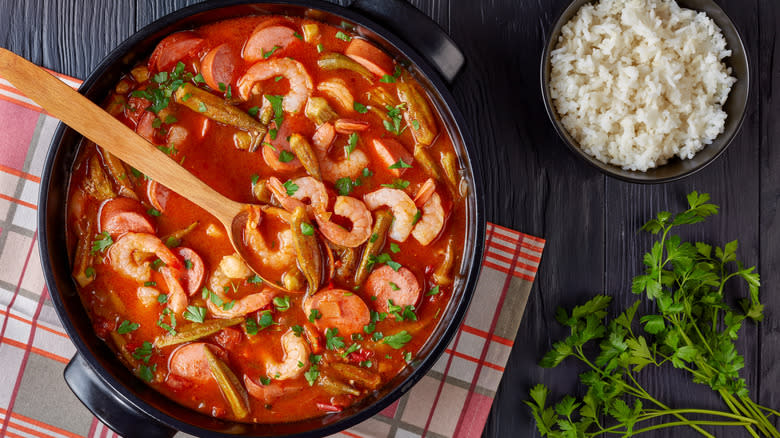
Due to their reputation as a delicacy, oysters are usually served as a standalone item whether cooked or not. Thanks to flavor and theatrical presentation methods, the mollusks are more than deserving of the spotlight, however, a failure to use them as a supporting ingredient will see cooks miss out on many exceptional dishes.
The most obvious example of this is Creole gumbo. In this dish, shucked oysters are not the main attraction but rather an ingredient that compliments more flavorful inclusions such as andouille sausage. While many might believe the oyster's nuance is lost in dishes like these, the opposite is true; they provide a clear briny note that cuts through the heavily spiced gumbo.
At Thanksgiving, oysters are often used to accompany the biggest centerpiece of all, turkey. This stems from an old British practice of stuffing various birds with oysters. The practice still works today with the oysters adding a much-needed zip to traditional stuffing.
Overcooking The Oysters
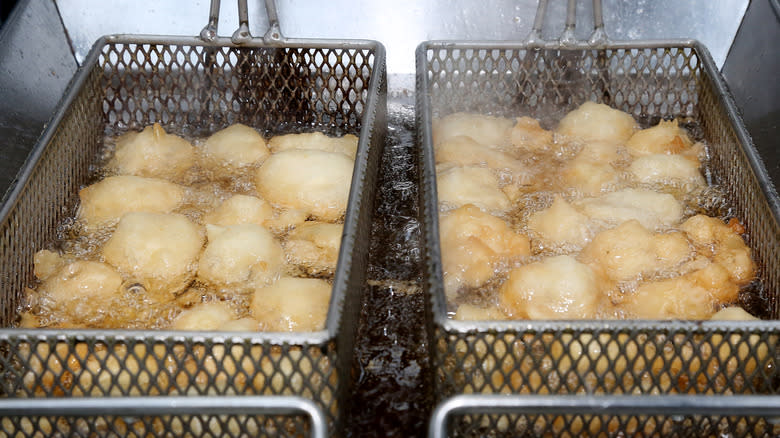
Oysters are fragile, small, and have much softer tissues than other marine and terrestrial animals. As a consequence, they are extremely easy to overcook so many chefs suggest using low heat or short durations when cooking them. For poaching, cook times as short as one minute are advised while the liquid's temperature should never surpass 140 F. The oyster is done when it puffs up and becomes firm to the touch.
Another way of telling when oysters are perfectly cooked is by watching the edges of the meat. When these begin to curl upwards it is an indicator that the oyster is cooked and it's time to remove them from the heat or poaching liquid. Of course, the oyster itself is not always visible. If it is being cooked while still in its shell, cooks should wait until it begins to open naturally. At this point, the oysters are perfectly cooked.
Unfortunately, the advice given by chefs and cooking publications does not always align with that provided by The Food and Drug Administration. For example, the FDA advises that oysters are boiled for another three to five minutes after the shells have opened. This ensures that any harmful bacteria have been destroyed. It may, however, lead to overcooked, rubbery oysters being served.
Failing To Sauce Or Garnish Them
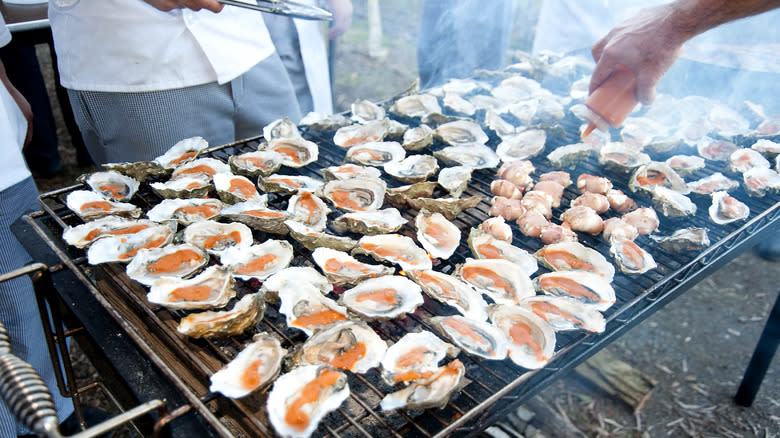
However oysters are cooked, they can usually be improved through the addition of a sauce or garnish. This will come as little surprise to those who enjoy eating the bivalves raw. After all, lemon juice is encouraged when slurping, and a small bottle of overworked Tabasco is a common sight at raw bars across the country.
When it comes to cooked oysters, the list of possible sauces is nearly endless. For grilled oysters, J. Kenji Lopez-Alt sings the praises of robust choices including a soy and sake glaze as well as a mixture of harissa paste and parmesan. When serving fried oysters, a classic, tangy remoulade is often favored while poached oysters are routinely topped with booze and dairy-based sauces.
The garnishes used to top cooked oysters are just as varied and should be selected to suit the technique used to cook the oyster. For example, soft, poached oysters get textural contrast thanks to a topping of sourdough croutons whereas roasted oysters are set off with a sprinkling of finely chopped bacon and parsley.
Binning The Shells
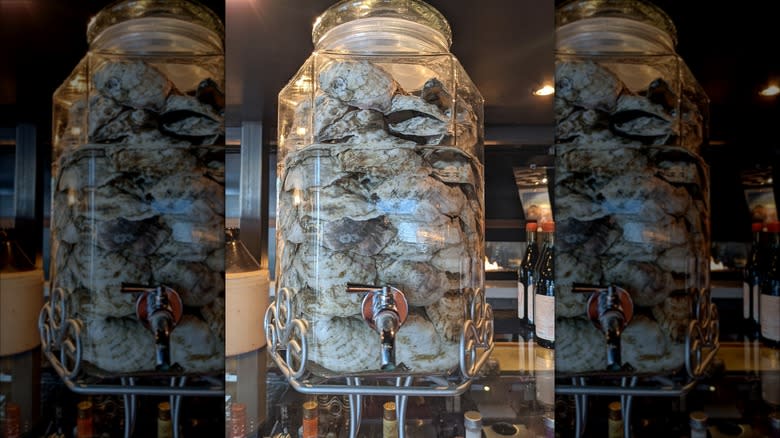
Once the oysters have been cooked, served, and enjoyed, many people instinctively throw the empty shells in the bin. This is a mistake as there is still plenty of flavor to be drawn from them. One of the best ways to access this flavor is to use them to infuse alcohol.
While oyster-infused alcohol can be used to make a variety of cocktails, the most prevalent is an oyster-flavored martini, sometimes called an oysterini. This take on the classic aperitif is arresting for reasons explained to GQ by Dan Joines, co-owner of an aperitivo distillery: "Normally with spirits, you're not talking about minerality or salinity. You're talking about acidity or sweetness or bitterness. So it's a bit of a different direction and that's what I think has captured people's attention." While it might sound overpowering, oyster-infused spirits and cocktails are generally quite accessible with mild briny flavors that complement, as opposed to overpowering, the other ingredients.
Read the original article on Daily Meal.

